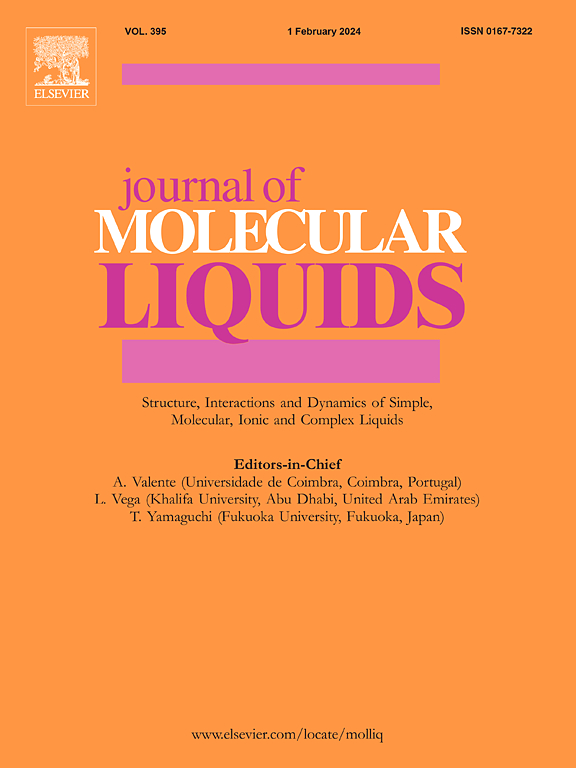深共晶溶剂辅助预处理Ulva海藻纤维素及硅表征
IF 5.3
2区 化学
Q2 CHEMISTRY, PHYSICAL
引用次数: 0
摘要
海藻是一种快速生长的海藻,是一种富含纤维素等多糖的可持续生物质资源。传统的纤维素提取方法通常依赖于刺激性的化学物质。在这里,我们研究了亲水和疏水的深共晶溶剂(DESs)作为预处理海藻衍生的无定形纤维素的绿色替代品。从共晶点形成的计算预测中选择DESs,并根据其在水介质中的分配系数和相行为进行分类。所选亲水性DESs为甜菜碱:尿素、氯化胆碱:尿素、氯化胆碱:柠檬酸,疏水性DESs为百里酚和癸酸、辛酸、甲酸或甲磺酸。用ChCl:尿素和百里香酚:癸酸预处理DESs有利于形成平均直径分别为53.51±14.00 nm和153.60±55.45 nm的海藻纤维素微纤维。产率高(75% - 84%),因为这些体系不会导致纤维素大量溶解。相反,含有百里酚:甲硫酸和ChCl:柠檬酸等有机酸的DESs有助于去除非纤维素杂质和无定形区域,提高了纯度和结晶度(结晶度指数分别为48.50和27.30)。SCMF易分散于水中,可吸附亚甲基蓝(达554.76 mg/g)。分子动力学模拟证实了实验结果。径向分布函数、配位数和氢键分析表明,DESs破坏了纤维素的氢键网络,影响了纤维的形态。疏水DESs保持了纤维的完整性,亲水DESs促进了纤维链的重排。目前的工作表明,DES预处理可以产生具有所需结构属性的SCMF,并为生物炼制应用提供了一种可持续和通用的方法。本文章由计算机程序翻译,如有差异,请以英文原文为准。

Deep eutectic solvent-assisted pretreatment of Ulva seaweed cellulose and in silico characterization
Ulva lactuca, a rapidly growing seaweed, is a sustainable biomass resource rich in polysaccharides such as cellulose. Conventional cellulose extraction methods often rely on harsh chemicals. Here, we investigated hydrophilic and hydrophobic deep eutectic solvents (DESs) as green alternatives for pretreating seaweed-derived amorphous cellulose. DESs were selected from computational predictions of eutectic point formation and classified by their partition coefficients and phase behavior in aqueous media. The selected hydrophilic DESs were betaine:urea, choline chloride (ChCl):urea, and ChCl:citric acid, and the hydrophobic DESs contained thymol and decanoic acid, octanoic acid, formic acid, or methanesulfonic acid. Pretreatment of the DESs with ChCl:urea and thymol:decanoic acid facilitated formation of seaweed cellulose microfibers (SCMF) with average diameters of 53.51 ± 14.00 and 153.60 ± 55.45 nm, respectively. High yields (75 %–84 %) were obtained because these systems did not result in extensive cellulose dissolution. Conversely, DESs containing organic acids, such as thymol:methanesulfonic acid and ChCl:citric acid, helped remove non-cellulosic impurities and amorphous regions, which increased the purity and crystallinity (crystallinity indexes: 48.50 and 27.30, respectively). The SCMF were readily dispersed in water and could adsorb methylene blue (up to 554.76 mg/g). Molecular dynamics simulations corroborated the experimental findings. Radial distribution function, coordination number, and hydrogen bond analyses revealed that DESs disrupted the cellulose's hydrogen-bond network and influenced fiber morphology. Hydrophobic DESs preserved the fiber integrity, while hydrophilic DESs promoted chain rearrangement. This present work demonstrates that DES pretreatment can produce SCMF with desired structural attributes and offers a sustainable and versatile approach for biorefinery applications.
求助全文
通过发布文献求助,成功后即可免费获取论文全文。
去求助
来源期刊

Journal of Molecular Liquids
化学-物理:原子、分子和化学物理
CiteScore
10.30
自引率
16.70%
发文量
2597
审稿时长
78 days
期刊介绍:
The journal includes papers in the following areas:
– Simple organic liquids and mixtures
– Ionic liquids
– Surfactant solutions (including micelles and vesicles) and liquid interfaces
– Colloidal solutions and nanoparticles
– Thermotropic and lyotropic liquid crystals
– Ferrofluids
– Water, aqueous solutions and other hydrogen-bonded liquids
– Lubricants, polymer solutions and melts
– Molten metals and salts
– Phase transitions and critical phenomena in liquids and confined fluids
– Self assembly in complex liquids.– Biomolecules in solution
The emphasis is on the molecular (or microscopic) understanding of particular liquids or liquid systems, especially concerning structure, dynamics and intermolecular forces. The experimental techniques used may include:
– Conventional spectroscopy (mid-IR and far-IR, Raman, NMR, etc.)
– Non-linear optics and time resolved spectroscopy (psec, fsec, asec, ISRS, etc.)
– Light scattering (Rayleigh, Brillouin, PCS, etc.)
– Dielectric relaxation
– X-ray and neutron scattering and diffraction.
Experimental studies, computer simulations (MD or MC) and analytical theory will be considered for publication; papers just reporting experimental results that do not contribute to the understanding of the fundamentals of molecular and ionic liquids will not be accepted. Only papers of a non-routine nature and advancing the field will be considered for publication.
 求助内容:
求助内容: 应助结果提醒方式:
应助结果提醒方式:


